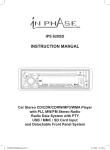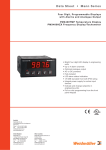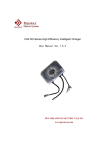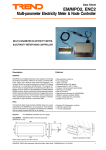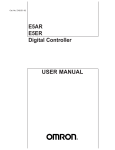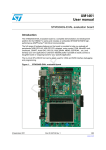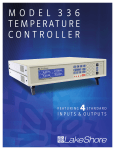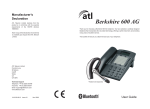Download SENSORS AND SYSTEMS TECHNOLOGY PRODUCTS REVIEW
Transcript
PRODUCTS REVIEW SENSORS AND SYSTEMS TECHNOLOGY PRODUCTS REVIEW Products range, code numbers Introduction The basic features and primary applications of FIS Based on its pre-eminent expertise in developing Metal products are described on the following pages. Oxide Semiconductor Gas Sensors, FIS today offers a range of products covering a wide field of applications including: FIS also develops and supplies various products including micro-computers, sensor evaluation units and others such as electrochemical or optical sensors. • Flammable gas detection FIS always finds the most effective approach to improve • Toxic gas detection gas detection technologies by studying the combination of both sensor technologies and application software. • Indoor air quality controls • Combustion monitoring/controls • Cooking controls FIS will continue to develop new sensors to meet the demands of the marketplace. • Ventilation controls The new range of semiconductor gas sensors developed by FIS has achieved an unprecedented reduction in heater power consumption, while preserving the typical features of semiconductor gas sensors such as: • High reliability • Long life • Ease of operation • Low cost Products range, code numbers The range of FIS products and the numbering system of the different models are illustrated here. S Category S: Semiconductor L: Lambda (semiconductor) E: Electrochemical P: Optical 2 P Type (semiconductor) B: Bead type P: Plate type P3: Plate (3 pins) P4: Plate (4 pins) T: Tube type C: Bulk type - 11 - 00 - (P1) Detection type Sub code Housing Indicated in the Products list This sub code shows the variation of specifications, heater voltage or other conditions (P1): (P2): (MC): (MP): (S): Plastic - type 1 Plastic - type 2 Mesh Ceramic Mesh Plastic Sintered Metal PRODUCTS REVIEW Products list Series Features SP series • Small heater power consumption (120 mW) • Small size • High sensitivity to flammable gases • Suitable for portable detectors/ battery operated devices • Reduced heater power consumption using a small gas sensing element • Low heater current • Variation of heater voltage • Wide variation of sensitivity characteristics Model (power consumption) Model (power consumption) Category No Dual gas 90- CO and methane SB-95 (PH : 120 mW - max.) Flammable gases 10-19 General purpose SB-11A (PH : 120 mW) SP-11 (PH : 400 mW) * Methane SB-12A under development SP-12A (PH : 380 mW) Propane/butane SB-15 (PH : 120 mW) SP-15A (PH : 380 mW) Hydrogen SB-19 (PH : 120 mW) SP-19 (PH : 315 mW) General purpose SB-31 (PH : 120 mW) SP-31 (PH : 315 mW) Alcohol SB-30 (PH : 120 mW) SP-32 (PH : 315 mW) R-22 SB-41 (PH : 120 mW) SP-41 (PH : 400 mW) R-134a SB-42 (PH : 120 mW) SP-42 (PH : 400 mW) Carbon monoxide SB-50 (PH : 120 mW - max.) Organic solvents Freon Toxic gases 30-39 40-49 50-59 Detection gas SB series SB-500 (PH : 120 mW - max.) Hydrogen sulphide Ammonia Oxidizing gases 60-69 Indoor Air Quality controls (air purifiers/ ventilation control systems) Air Damper control in automobiles Notes MW AQ SB-53 under study Ozone Nitrogen oxides Cooking controls SP-51 under study SP-53 (PH : 315 mW) SP-61 under study SB-62 under study Chlorine SP-65 under study General purpose SP-MW0 (PH : 400 mW) Humidity SP-MW1 (PH : 400 mW) Alcohol SP-MW2 under development Combustion gas SP-MW3 under development General purpose SB-AQ1A (PH : 120 mW) SP-AQ1/SP-AQ2 (PH : 315 mW) SP3-AQ2/SP3-AQ2Y (PH : 315 mW) AD Cigarette smoke SB-AQ4 (PH : 140 mW) SP-AQ3 (PH : 315 mW) CO2 SB6-AQ6 under development SP6-AQ6 Gasoline exhaust gas SB-AD1 under development SP-AD1/SP-AD3 under development Diesel exhaust gas SB-AD2 under development SP-AD2/SP-AD3 under development • Using a Dynamic Driving method in the heater operation (pulse voltage), the average heater current can be reduced to 25 mA (example with 5 V) • Variation of heater voltage is available (Standard: 5 V, option-1:12 V and option-2: 24 V) * Pre-classified version is available for the SP-11 3 PRODUCTS REVIEW SB series General Heater coil The SB series achieves a dramatic reduction of power consumption in semiconductor gas sensor applications. Compared with conventional gas sensors, only 15% of Gas sensitive semiconductor the power is required to detect methane, propane or Lead wire 0.5 mm other gases. Using this design, increased sensitivity and improved cross sensitivity in flammable gas detection, CO 0.3 mm or solvents detection with quick response are achieved. Structure Fig 1. Sensing element The sensing element is a mini bead type semiconductor mainly composed of tin-dioxide (SnO2). A heater coil and an electrode wire are embedded in the element (Fig 1). The 100 mesh SUS 316 gauze (double) element is installed in the metal housing which uses Sensing element Metal housing (Nickel plated brass) double stainless steel mesh (100 mesh) in the path of gas flow. The mesh is an anti-explosion feature (Fig 2). The Plastic base sensor has 3 pins for output signal and heater power Electrode pins supply. The small sensor reduces the required space and the size of products. The SB-50 uses an active charcoal filter as shown in Fig 6. Fig 2. Structure: standard housing Operating conditions Fig 3a and Fig 3b indicate the pin layout and equivalent circuit and Fig 4 shows the standard circuit of the SB 2 (side view) series. The applied heater voltage regulates the sensing RS element temperature to obtain the specific performance RH of sensors. The change in the sensor resistance is generally fixed or variable load resistor (RL) in series with the sensor resistance (RS). 3 1 obtained as the change of the output voltage across the 1 2 3 identification mark Fig 3a. Pin layout Fig 3b. Equivalent circuit Note: In this circuit, Pin No.1 with indication mark (Fig 3a) should be used as a ‘common terminal’ for both heater VC : Circuit Voltage VH : Heater Voltage RL : Load Resistance voltage (VH) and circuit voltage (VC). RH : Heater Resistance VRL: Voltage across load resistance + RL Standard operating conditions: VC: Less than 5 V DC RL: Variable (> 750 W ) VH: 900 mV (SB-11, SB-31, SB-AQ1) 1000 mV (SB-AQ4) 900 mV-3 sec / 200 mV-7 sec (SB-50) Remarks: Polarity of VC and VH is important. Apply the VC and VH as shown in the circuit diagram. 4 VC + VH Fig 4. Standard circuit 3 2 RH 1 RS VRL PRODUCTS REVIEW SB series Dimensions Fig 5 shows the dimensions of the SB series (standard Stainless steel mesh 4.5 housing). Configurations Fig 6 shows the configurations of the SB series: standard 7.6 Other housing Lead wire Sensor cover 2.0 Heater coil Sensing element 8.4 housing and SB-50 with active charcoal filter. Special sensor housing with an external sintered metal Plastic moulding 5.0 cover is available (example: FIg 7). Electrode pin 1.0 1.5 Sensitivity characteristics (typical data) 0.25 2.54 2.54 The sensitivity characteristics of semiconductor gas sensors are shown by the relationship between the sensors resistance (RS) and concentration of gases. The sensor 0.8 0.8 0.8 resistance decreases with an increase of the gas Scale: mm concentration based on a logarithmic function (see page 14 for details of sensing mechanism). The standard test Fig 5. Dimensions: standard housing conditions of each model are calibrated to meet a typical target gas and concentration. For example, methane 1000 ppm for flammable gas detection, hydrogen 100 ppm for Standard SB-50 (with active charcoal filter) 100 mesh SUS 316 gauze hydrogen detection or ethanol 300 ppm for solvents Active charcoal detection. If different conditions are required for other Metal housing (Nickel plated brass) specific gas detection, please consult FIS. Plastic housing Electrode pins Figs 8 to 13 on the next page show the typical sensitivity characteristics data of SB series gas sensors. In these Fig 6. Configurations: standard housing and SB-50 diagrams, the sensor resistance change is normalized by the RS at specific conditions. Sintered metal cover 15.0 23.0 Sensor Holder PC board Potting compound Lead wire 11.2 Fig 7. SB series with sintered metal housing 5 PRODUCTS REVIEW SB series 100 RS / RS (ethanol 300 ppm) RS / RS (at iso-butane 1000 ppm) 10 1 0.1 air level methane iso-butane hydrogen ethanol 10 1 0.1 0.01 0.01 10 100 1000 Gas concentration (ppm) 10000 1 Fig 8. SB-11A for Hydrocarbons 100 1000 10 100 1 air level methane hydrogen ethanol 0.1 100 1000 Gas concentration (ppm) 10000 10 1 CO hydrogen ethanol CO 0.1 0.01 1 10 100 1000 Gas concentration (ppm) 1 10000 Fig 10. SB-19 for Hydrogen 10 100 1000 Gas concentration (ppm) 10000 Fig 11. SB-50 for CO 1 RS / RS (in air) RS / RS (in air) 1 air level methane hydrogen ethanol 0.1 0.1 air level hydrogen ethanol CO 1 10 Gas concentration (ppm) 100 Fig 12. SB-AQ1 for Air Quality Controls (general) 6 10 Fig 9. SB-31 for Solvents RS / RS (CO 100 ppm) RS / RS (hydrogen 100 ppm) air level methane iso-butane hydrogen ethanol CO 1 10 Gas concentration (ppm) Fig 13. SB-AQ4 for Air Quality Controls (smoke) 100 PRODUCTS REVIEW New developments: SB series 1000 SB-95: CO/methane sensor Using both high and low sensor temperature in the periodic temperature change method (same operation Air 100 method as the SB-50), it is possible to detect both CO and Methane 1000 ppm RS (kW ) methane selectively with single element. Fig 14 shows a typical temperature dependency 10 characteristic of the SB-95. When the sensor is operated with high/low periodic operation (Fig 15), sensor signal 1 CO 1000 ppm changes according to the temperature dependency characteristics. By detecting the sensor signal at sufficient HIGH LOW timings (at a high temperature for methane and at a low 0.1 100 temperature for CO), selective detection of both methane 200 300 Sensor temperature (ºC) 400 500 Fig 14. SB-95: Temperature dependency characteristics and CO has been achieved. Figs 16 and 17 show the sensitivity characteristics of the SB-95, at high temperature Using this concept, development of CO or methane, or both CO and methane detectors can be developed using the same sensor and circuit. Heater voltage and at low temperature signals respectively. High 0.9 V Low 0.2 V 5 sec 10 sec in CO or methane Sensor output (VRL) in air in air in methane in CO Detection point: high low Time Fig 15. SB-95: Operating conditions and output signal 20 100 10 RS / RS (CO 100 ppm) RS / RS (at methane 1000 ppm) 10 5 2 1 1 air level 0.1 methane 0.5 CO CO hydrogen hydrogen ethanol 0.2 0.01 100 1000 10000 Gas concentration (ppm) Fig 16. SB-95: Sensitivity at HIGH signal for methane 1 10 100 1000 Gas concentration (ppm) 10000 Fig 17. SB-95: Sensitivity at LOW signal for CO 7 PRODUCTS REVIEW SP series General Alumina substrate The SP series was developed using an advanced thick film Sensing material Heater small and thin ceramic substrate, a 50% reduction in 2 mm printing technology. By applying this technology on a Lead wires current and power is achieved. Combinations of new design, variations of sensing materials and excellent 2 mm performance and a wide variation in the product range. Electrodes 0.3 mm controllability have lead to improvements in sensor Fig 18. Sensing element 100 mesh SUS 316 gauze (double) Structure The sensing material is formed on the alumina substrate Plastic housing on which the gold electrodes are printed. A thick film Sensing element Plastic base Electrode and heater pins heater of ruthenium-oxide or platinum is printed on the reverse of the substrate (Fig 18). The element is installed in the plastic or mesh type housing which uses a double stainless steel mesh (100 Fig 19. Structure: standard type (P1) mesh) in the path of gas flow (Fig 19: standard type). The sensor has four pins for output signal and heater (Top view) 5 power supply and one free pin for identification. 1 4 RS Operating conditions 3 2 3 2 Fig 20a indicates the pin layout and Fig 20b shows the 2 3 shown in Fig 21. The applied heater voltage regulates the sensing element RH (Bottom view) equivalent circuit. The standard circuit for the SP series is 4 1 1 4 temperature to obtain the specific performance of sensors. As in the SB series, the change in sensor resistance is obtained from the change in the output 5 Fig 20a. Pin layout Fig 20b. Equivalent circuit voltage across the fixed or variable load resistor (RL). 4 VH VC RH RS 1 RL Standard operating conditions: VC: 24 V max (DC/AC) VH: 5.0 V ± 4% (DC/AC) RL: Variable (PS < 15 mW) PS = ( VC - VRL )2/RS 8 3 Fig 21. Standard circuit Remarks: Polarity of the circuit voltage (VC) is not important. 2 VRL PRODUCTS REVIEW SP series Dimensions Fig 22 shows the dimensions of the SP series (standard housing). Stainless steel mesh Configurations: variation of housing design Lead wire Sensing element Fig 23 shows the variation of the SP (5 pin) configuration. Other variations of sensor pin layout and housing designs 17.0 are available. 16.5 b) SP4 type base (4 pin) with compact plastic housing Stainless steel mesh Sensing element Lead wire Plastic housing Plastic base 6.5 • Fig 24: a) SP3 type base (3 pin) with compact plastic housing Nickel pin • Fig 25: Metal base (TO-39 type 4 pin) 9.5 1.0 • Fig 26: Metal base with a sintered metal external housing Sensitivity characteristics (typical data) 45 45 Figs 27 to 38 on the following pages show the typical Scale: mm sensitivity characteristics data of SP series gas sensors. In Fig 22. Dimensions: standard housing these diagrams, the change in sensor resistance is normalized by the RS at specific conditions. Plastic type (P1) Mesh type (MC/MP) Fig 23. Configuration of sensor housing Sintered metal cover 12.0 14.0 11.5 12.0 15.0 Scale: mm 23.0 Sensor Holder Fig 24. Compact plastic housing: SP3 (left) and SP4 (right) PC board Potting compound Lead wire 11.2 Fig 26. Sintered metal housing with metal base Fig 25. Metal base (TO-39 type 4 pin) 9 PRODUCTS REVIEW SP series 10 RS / RS (at methane 3000 ppm) RS / RS (at iso-butane 1000 ppm) 10 1 air level methane propane iso-butane hydrogen ethanol 1 air level methane iso-butane CO hydrogen ethanol 0.1 0.1 100 1000 Gas concentration (ppm) 10000 100 Fig 27. SP-11 for Hydrocarbons 100 RRS / RS (at Hydrogen 100 ppm) RS / RS (at iso-butane 1500 ppm) 1 air level methane iso-butane CO 10 1 air level methane hydrogen ethanol CO 0.1 hydrogen ethanol 0.01 0.1 100 1000 Gas concentration (ppm) 1 10000 100 1000 10000 Fig 30. SP-19 for Hydrogen 10 10 1 RS / RS (in air) 100 1 air level methane iso-butane hydrogen ethanol CO 0.1 10 Gas concentration (ppm) Fig 29. SP-15A for Propane/butane (LP-Gas) RS / RS (at ethanol 100 ppm) 10000 Fig 28. SP-12A for Methane (Natural gas) 10 0.1 air level methane iso-butane hydrogen ethanol CO 0.01 0.01 0.001 1 10 100 1000 Gas concentration (ppm) Fig 31. SP-31 for Solvents 10 1000 Gas concentration (ppm) 10000 1 10 100 1000 Gas concentration (ppm) Fig 32. SP-32 for Alcohol 10000 PRODUCTS REVIEW SP series 10 RS / RS (at R-134a 100 ppm) RS / RS (at R-22 100 ppm) 10 1 air level methane iso-butane R-22 ethanol R-134a 0.1 0.01 10 100 1000 Gas concentration (ppm) 10000 1 air level methane iso-butane R-22 ethanol R-134a 0.1 0.01 10 Fig 33. SP-41 for Freon (R-22) 100 1000 Gas concentration (ppm) 10000 Fig 34. SP-42 for Freon (R-134a) 10 RS / RS (at 11.75 g/m3) RS / RS (at ammonia 100 ppm) 1 0.1 air level ammonia H2S hydrogen ethanol CO 0.01 1 humidity 0.1 1 10 100 Gas concentration (ppm) 1 1000 Fig 35. SP-53 for Ammonia 1 1 RS / RS (in air) 10 RS / RS (in air) 100 Fig 36. SP-MW1 for Cooking Controls (general) 10 air level H2S hydrogen ammonia ethanol CO 0.1 10 Absolute Humidity (g/m3) 0.1 air level hydrogen ethanol 0.01 0.01 0.1 1 10 Gas concentration (ppm) Fig 37. SP-AQ2 for Indoor Air Quality (general) 100 0.1 1 10 Gas concentration (ppm) 100 Fig 38. SP-AQ3 for Indoor Air Quality (smoke) 11 PRODUCTS REVIEW Related products Microprocessors: IC- series 15 1 14 8.8 ± 0.2 indoor air quality controls, CO detection, domestic gas alarms, etc. Application of IC series 0.25 +0.1 -0.05 28 10.16 ± 0.25 (microcomputers) for various applications such as 0-15° FIS develops specially designed microprocessors enables efficient and economical solutions in the development of applied products. 26.1 max 1.0 ± 0.1 1.243TYP 3.0±0.3 3.8±0.3 0.3 min 3.3±0.2 25.6 ± 0.2 0.46 ± 0.1 unit: mm 1.778 Fig 39. Standard compact plastic DIL package 15 9.0 max 11.8 ± 0.3 0.15 ± 0.05 28 1.5 ± 0.4 14 18.9 max 0.43 ± 0.1 1.27 ± 0.05 0.1 ± 0.1 2.5 max 1 unit: mm Fig 40. Flat package for SMD Field CO detection Model IC-04-1 (OTP) IC-04-2.1 (OTP) IC-04-2.2 (EMC1004: SMD) Description Features and functions A series of microprocessors for driving the mini SB50 sensor for reliability, low power, quick response and low cost CO detectors. These microprocessors include useful functions for CO alarm devices. Variations of functions and units are available with different versions. Standard product is the IC-04-2.2. with SMD type package. • Heater power supply (Dynamic Driving method), signal detection (periodic sensor temperature change operation) • Alarm functions (including various options) • Temperature and humidity compensation • Memory function for calibration • Fail-safe signal, etc. A microprocessor for domestic gas alarms for SP series including various functions which provide high reliability in flammable gas leak detection. • Initial delay, alarm delay, temperature compensation, fail-safe and other functions OTP: One Time Processor Domestic gas alarms IC-05 (EMC6010: DIP) (EMC6020: SMD) 12 PRODUCTS REVIEW Modules Evaluation modules: EVM series The EVM series includes modules with basic operation/detection circuits and/or examples of application circuits using FIS sensors and microprocessors. General purpose Model EVM-SB-01: - SB series - SB-11 (for flammable gas detection) EVM-SB-07: - SB series Description and functions Dimensions: Unit: mm, Scale: approx. 1/2 Pre-calibrated module (e.g. at 10% LEL for flammable gas detection). Includes a standard driving circuit for evaluating the SB series gas sensor • • • • 100 Sensor 22 Field Compact design Low power consumption 5 V DC input VRL output (0 - 4 V) White Red Black IC VR 37 Module includes the ‘Dynamic Driving’ operation circuit for the SB series 65 Easy operation Low power and low current 5 V DC input VRL output EVM-SB-07 SB sensor VR2 50 • • • • 1 2 3 IC1 CN1 VR3 VR1 IC2 EVM-SB-02 - SB-AQ series + IC-02 Module includes driving circuit for the SB-AQ1 or SB-AQ4 and microprocessor IC-02 using ‘Dynamic Driving’ operation with low power consumption • Low power and low current • LED’s indication and control signals for a fan (3 levels) • 12 V DC input (9 V battery operation is also possible) • Pre-calibrated • Auto/manual switch and a timer function 90 SB-AQ VR Buzzer X1 90 Air quality controls (air purifiers) VR VR IC-02.2 12 V VR GND LED SW Module for evaluating the mini CO sensor SB-50 with microprocessor IC-04. Periodic sensor temperature change operation with 10 seconds cycle (High: 3 secs and Low: 7 secs). Low current consumption using a ‘Dynamic Driving’ operation method Thermistor X1 SB-50 IC-04 Buzzer V G LED VR Condenser ZNR - LED Terminal • Mains power operation with no transformer (220 V and 100 V versions) • Low power consumption of 60 mW. • Visual alarm, buzzer and output signals (alarm and sensor signal output) 95 AC AC + EVM-SB-05 - SB-50 + IC-04 70 CO detection 13 PRODUCTS REVIEW Modules Example of applied products Examples of commercial application designs are also available such as EVM-SB-08 and DGA-ES. Field CO detection Model EVM-SB-08 - SB-50 + IC-04 Description and functions Dimensions: Module for general purpose using the SB-50 with microprocessor IC-04. 80 • Compact design • 5 V DC input • 2 level alarm signal output (for remote alarm), initial delay, fail-safe and other functions DGA-ES: - SP-12A/SP-15 + IC-05 LED Sensor CN1 30 TH VR An example of domestic gas alarm (for natural gas or LP-Gas) using the SP-12A/ SP-15 and IC-05 • Power supply: 100 V, 220 V AC or other conditions • With functions such as initial delay, alarm delay, temperature compensation, etc. • Natural gas (methane) and propane versions X1 SB-50 124 X1 LED1 ZNR1 IC -05 LED2 Transformer 62 Flammable gas detection Unit: mm, Scale: approx. 1/2 LED3 CN TH1 CN1 Sensor VR Relay Terminal block Buzzer Pre-calibrated modules: PCM series Combinations of sensors and small PCBs including fixed and variable resistors (RL). These modules are calibrated at suitable conditions for indoor air quality or other applications and avoid calibration process in the assembly of applied products. Air quality controls Model PCM-SP/ST-01 - SP-AQ series - ST-AQ series Description and functions Dimensions: Unit: mm, Scale: approx. 1/2 Pre-adjusted sensor module for air quality controls 100 • Sensor + PCB + cable • 5 V DC input • Output signal is specified by the sensitivity to hydrogen White Red Black 22 Field VR 1 2 3 37 PCM-SP-02 - SP-12A/SP-15 Pre-adjusted sensor module for methane or LP-Gas detection with temperature compensation • Sensor + PCB + terminal • 5 V DC input • Output signal is specified by the sensitivity to methane /LP-Gas 40 TH 23 Flammable gas detection R VR Pre-classified sensor: PC version Pre-classified sensors are supplied with code numbers showing sensor resistance level at specified conditions. Using this version, specific levels of output signal (VRL) are obtained in the applied products. See SP-11/SP-12 User’s Manual for details. 14 PRODUCTS REVIEW Metal oxide (SnO2) semiconductor gas sensor The conductivity of Tin dioxide (SnO2) metal oxide semiconductor materials changes according to gas concentration changes. This is caused by adsorption/desorption of oxygen and reaction between surface oxygen and gases. These reactions cause a dynamic change of electric potential on SnO2 crystal and results in the decrease of sensor resistance under the presence of reducing gases such as CO, methane, hydrogen. The figures below indicate the sensing mechanism of the SnO 2 gas sensor. (Sensing element) (Sensor unit) Sensing material Sensing element 2 mm SnO2 particles: sub-micron to several ten micron Microscopic image of SnO2 particles (secondary particles) (In the presence of CO) O2- + CO ➔ CO2 + eO - + CO ➔ CO2 + eO2- + CO ➔ CO2 + 2e- O2 O2- e- e- O2- Grain boundary O2- e-SnO2-X e e- e O2O2 O2- e- e- e- e- O2- O2- O2- e- SnO2-X ee- e- e- O2- O2O2 O2O2O2 O2- - e e- e- e- SnO2-X e- e O2- e- e- e e (several hundred angstrom Å) O2- e- e- SnO2-X e- SnO2 crystals e- e- e- CO O2 O2 O2 + e- e- e- O2- ee- ee- eSnO2-X e- - ee e e eO2- e- e- ee- e- SnO2-X e- e O2- e- e- O2 O2- ➔ O2 + e- O2e- O - O - ➔ 1/2O2 + e- 1/2O2 + ➔ 1/2O2 + 2e- ➔ O 2- e- ee- e- CO e- ➔ Potential barrier changes e- e- e- e- O2- O2 CO O2- O2- O2- O2- ➔ O2 + eO - ➔ 1/2O2 + eO 2- ➔ 1/2O2 + 2e- O2 + e- ➔ O21/2O2 + e- ➔ O 1/2O2 + 2e- ➔ O 2- O2 CO O2 O 2- ➔ 1/2O2 + 2e- e- e- e- e- e- in air In the presence of CO Low conductivity (high resistance) High conductivity (low resistance) e- (kW ) 100 Sensor Resistance (log scale) Sensor resistance in air is kept at high level: e.g. > 100 kW . In the presence of reducing gases, sensor resistance decreases with increase of gas concentration. air level 10 Reducing gas 1 10 100 1000 (ppm) Gas concentration (log scale) 15 FIS INC. 2-5-26, HACHIZUKA, IKEDA, OSAKA. 563 JAPAN TEL: +81-727-61-5886 FAX: +81-727-61-5876 CONTACT: In the interest of continued product improvement we reserve the right to change design features without prior notice revised June, 1998. Version 4.2
















